In last month’s Short Story, Matthew Kennedy paraded us through the theatrical follies of the Hewitts, as well as the vivid and varied theatrical design collection of Cooper Hewitt. This month, Emily Orr, Cooper Hewitt’s assistant curator of modern and contemporary American design, introduces us to the chic and imaginative world of store window displays through the photography of Thérèse Bonney and the merchandising genius of Gene Moore.
Margery Masinter, Trustee, Cooper Hewitt, Smithsonian Design Museum
Sue Shutte, Historian at Ringwood Manor
Matthew Kennedy, Publishing Associate, Cooper Hewitt, Smithsonian Design Museum
Artistic, Rather Than Lifelike
The history of the design of the places and spaces of shopping can be discovered in Cooper Hewitt’s permanent collection and archives, as well as in the holdings of libraries across the Smithsonian. From shopping bags and display signs to architectural elements and shopfronts, these elements together reveal the great attention paid to and investment in not only what modern stores sold but how they sold it. The design of the retail environment continues to shape the shopping experience, encouraging repeat visitors, serving as a point of competition amongst stores, and cultivating innovation. Since the late nineteenth century, sophisticated visual merchandising earned recognition as a principal industry as well as an art of major shopping cities worldwide. The show window has risen to prominence as savvy exhibition space for commercial strength and creative excellence.
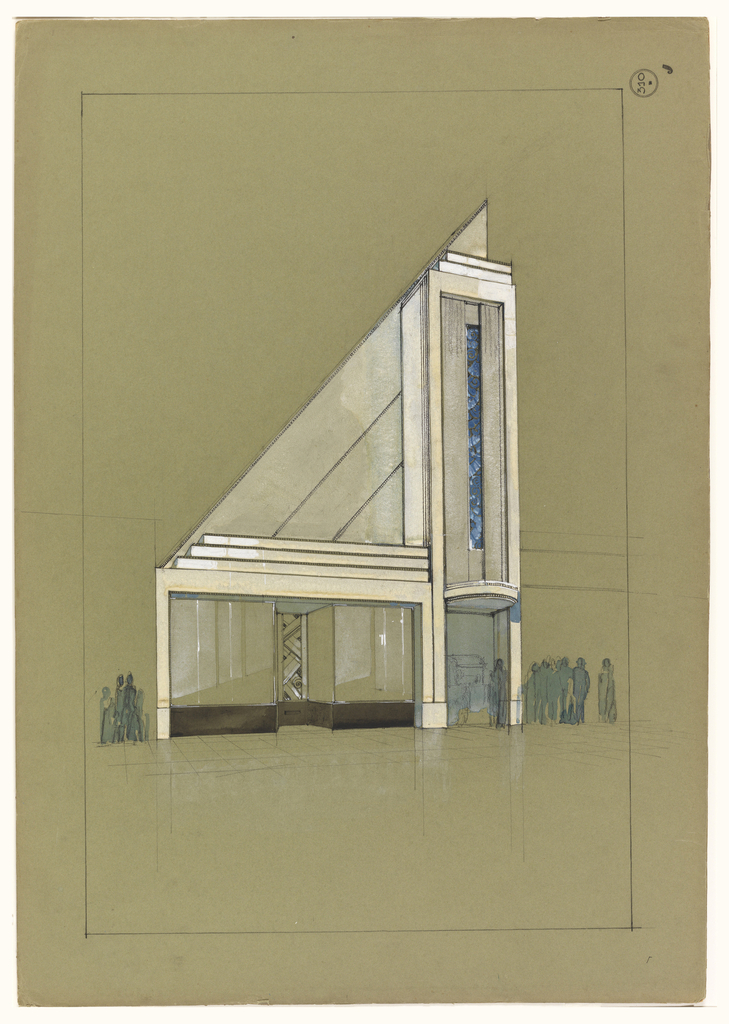
Drawing, Design for a Shopfront with Triangular Facade, ca. 1925; Designed by Kilemnik & Cia (Argentina); Brush and white and beige gouache, blue and brown watercolor, graphite on green paperboard; 69.9 x 48.6 cm (27 1/2 x 19 1/8 in. ); Gift of Maureen Cogan, 1999-39-3
The Smithsonian has recently digitized two collections that capture the beauty, imagination, and selling power of the show window. Supported by the Smithsonian Institution Women’s Committee, 4,000 photographs collected and taken by Thérèse Bonney, an American who served as Paris fashion correspondent for the New York Times from 1925 to 1935, have been digitized. These images document all aspects of modern design, from architecture and fashion to furniture and show windows. The second is a collection of photographs that chronicle the imaginative window displays of Tiffany & Company’s flagship store on Fifth Avenue in New York City during Gene Moore’s tenure as artistic director from 1955 to 1994. Tom Beebe, former creative director for Paul Stuart and Moore’s mentee and friend for many years, raised awareness for the importance of this project. This collection of photographs originally consisted of seventy-eight notebooks containing approximately fifty 8 x 10 inch photographs each, assembled by Moore and gifted to Cooper Hewitt, Smithsonian Design Museum in 1997 before being transferred to the Smithsonian’s National Museum of American History in 2012.
The show window is the primary medium through which stores first reach out to the public. It is a stylistic statement that can be read by consumers for evidence of the quality and personality of the business that it advertised. Beginning in the nineteenth century, plate glass was synonymous with progress. Large windows became a recognizable element of the city experience, a priority in the building program of large emporiums, and set up a new public exhibition space for the viewing of material goods. On the exterior of buildings along major shopping avenues, continuous show windows communicated order through their linear placement and variety through their diverse displays.
As the window display profession solidified at the turn of the twentieth century, a wealth of guidebooks and trade periodicals provided advice to those active in this new design field. The Merchant’s Record and Show Window, also digitized by the Smithsonian, was the leading American periodical on visual merchandising and offered continual advice on styles and strategies. In July of 1920, an article summed up the impact of visual merchandising:
“The successful display, functioning in its capacity as a selling force accomplishes the following results: First, it attracts the attention of the passerby to the merchandise on display in the store window; second, it arouses an interest in the merchandise; third, it creates the desire to possess; and, fourth, the will to have. Every display, perfect in construction and arrangement, has this power over the open mind of the shopping public, and such an instrumentality for sales, may be properly considered the most formidable equipped salesman of the stores selling force.”[1]
When arranged in a particularly persuasive manner, the show window achieved an agency that could turn passersby into consumers and secure a sale. Such articles, widely read by window display designers and store owners, contributed to retail’s increased investment in the show window’s artistic effects in order to increase their potential profitability.
Thérèse Bonney’s photographs of Parisian storefronts document a range of visual merchandising styles used to catch the eyes of pedestrians in the 1920s and 1930s. Many of Bonney’s photographs capture dramatic textile displays with swoops of swaths of fabric across the plate glass pane.
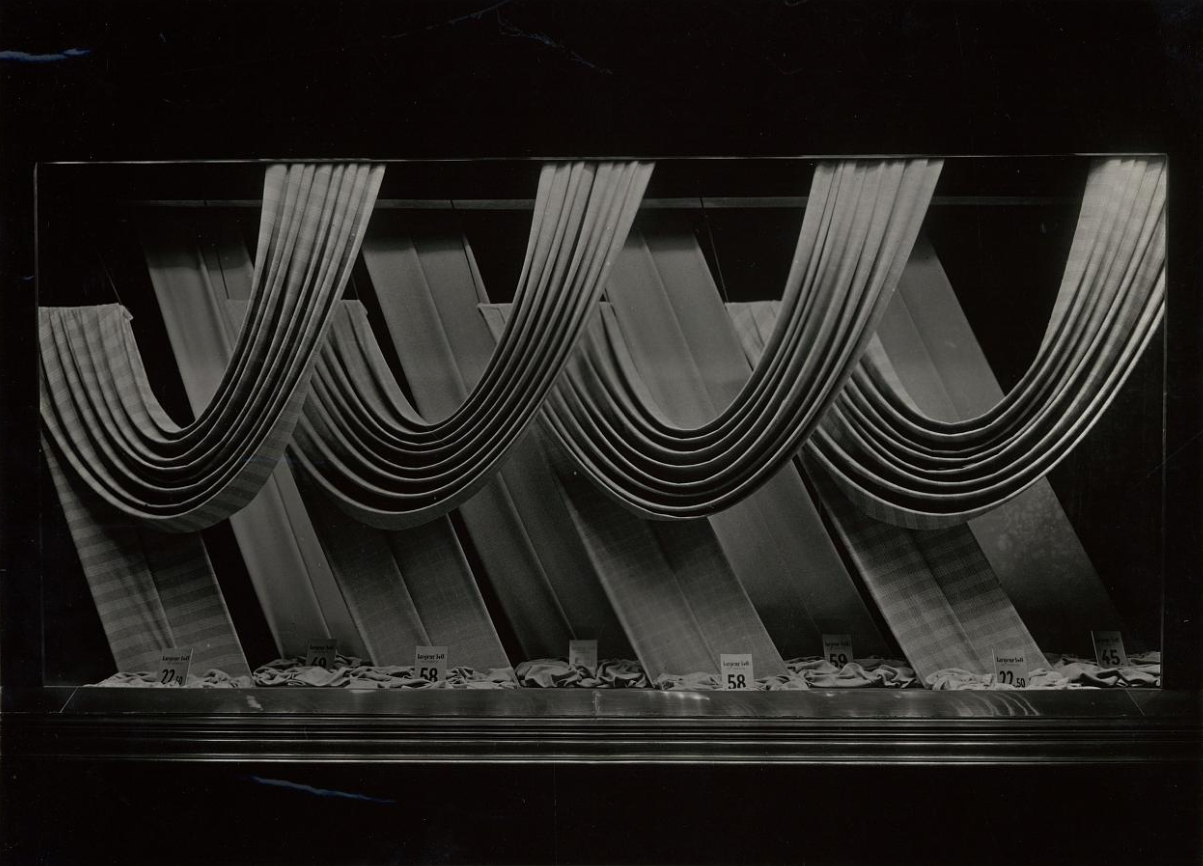
Window Display of Different Types of Fabric, France, 1925–35. Thérèse Bonney Collection, WDT017-A. Smithsonian Libraries.
The profession of window dressing had its roots in the dry goods houses that serviced the textile trade. Many of the first prescriptive texts on window dressing centered on textiles. The manipulability of yard goods and smaller individual wares, most notably handkerchiefs, made the execution of ambitious arrangements possible. Textiles’ function after all relied on their ability to drape on the body or in the home. Therefore, the weight and fold of fabrics, as well as texture and color, were essential features to communicate effectively in a window display.
From the late nineteenth century, a major event in the retail calendar was The White Sale in January, a sale entirely devoted to the store’s stock of white textiles whose color and pliability lent them to thematic displays evoking the artic climate. From a practical perspective, this sale represented the department store’s creation of a new buying rhythm for the year in order to clear out stocks and stimulate sales again following the Christmas rush. Here below Bonney has chosen a window display on view during the White Sale at the Bon Marché as her subject. A mannequin who stands central in the window with radiating strips of white lace around her. Her arms are open, welcoming viewers to purchase all that she has on offer.
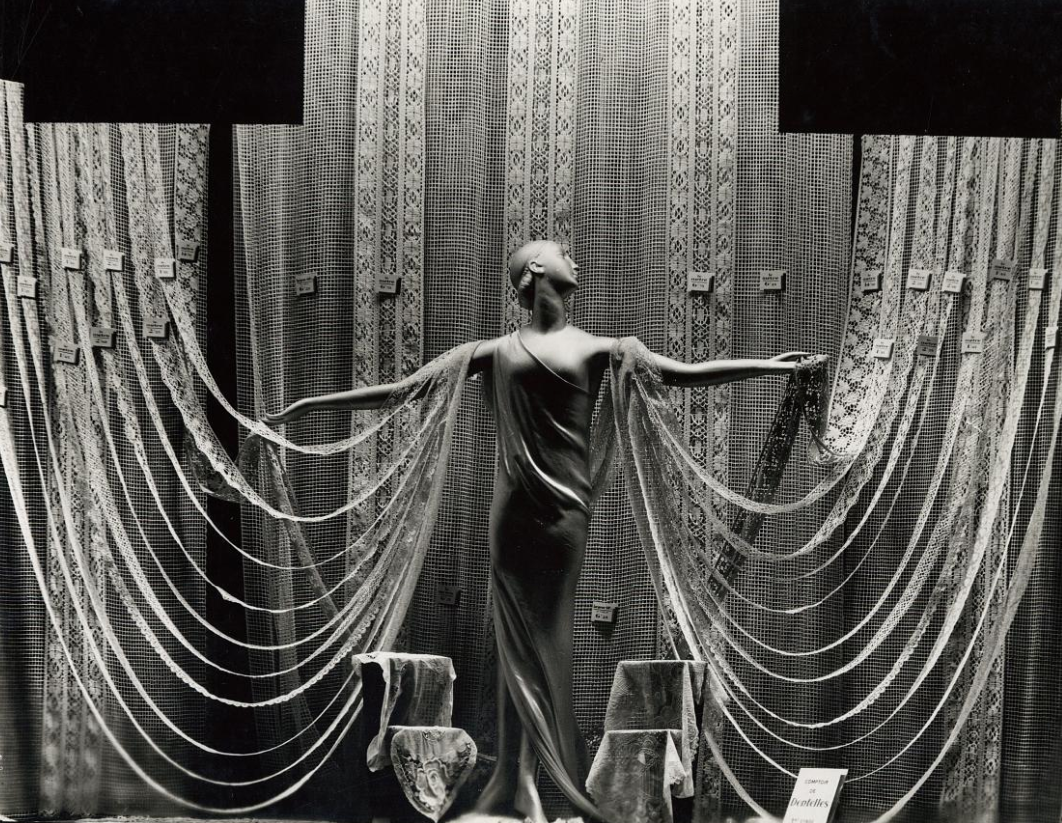
Window display. France, 1925–35. Lace for the annual White Sale of Au Bon Marché department store. Thérèse Bonney Collection, WDT012-A. Smithsonian Libraries.
While for the rest of the year the department store was teeming with a diverse mix of wares of various patterns, colors, and forms, the White Sale typically cloaked the store in simple white textiles. Émile Zola’s novel Au Bonheur des Dames, based on the theatrics of the Bon Marché, described the White Sale as “a riot of white.”[2]
As seen in the White Sale window, the mannequin was a prominent component of many window displays, whose styling and silhouette aligned with modern art in the early twentieth century. One Bonney photograph shows three metallic mannequins by the leading Parisian manufacturer Siégel.
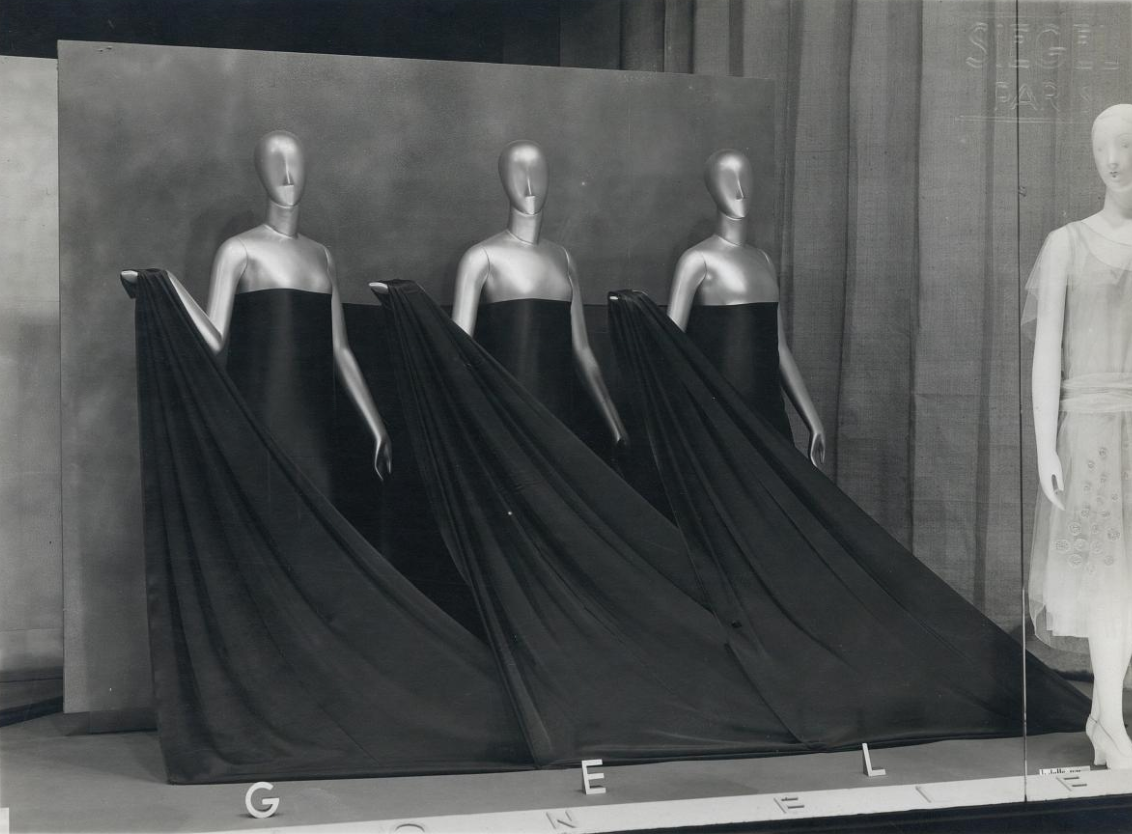
Window display. France, 1925–35. Three silver lacquered mannequins exhibiting fabric. Made by Siegel. Thérèse Bonney Collection, WDT070-A, Smithsonian Libraries.
Vogue reported that the “new mannequin” of abstract form and character, as seen above, were first presented in 1924 at the Salon d’Automne in Paris.[3] More than ever before, in the 1920s the mannequin was praised for its artistic, rather than lifelike effect, which was a welcome complement to contemporary fashion designs, modern furniture forms, and geometric patterns that made up the show window presentations. Here the expressive face and attitude of the mannequins harmonized with the triangular sweeps of fabric that they held.
Beguiling Effects of Surrealism
Many of the show window displays that Bonney documented were large-scale presentations that left little blank space behind the plate glass. Merchandise, mannequins, shopfittings and props filled the picture plane. On the other hand, Gene Moore, artistic director at Tiffany’s for much of the second half of the twentieth century, built his reputation on sparse displays whose severely edited presentation nonetheless made an incredible visual impact.
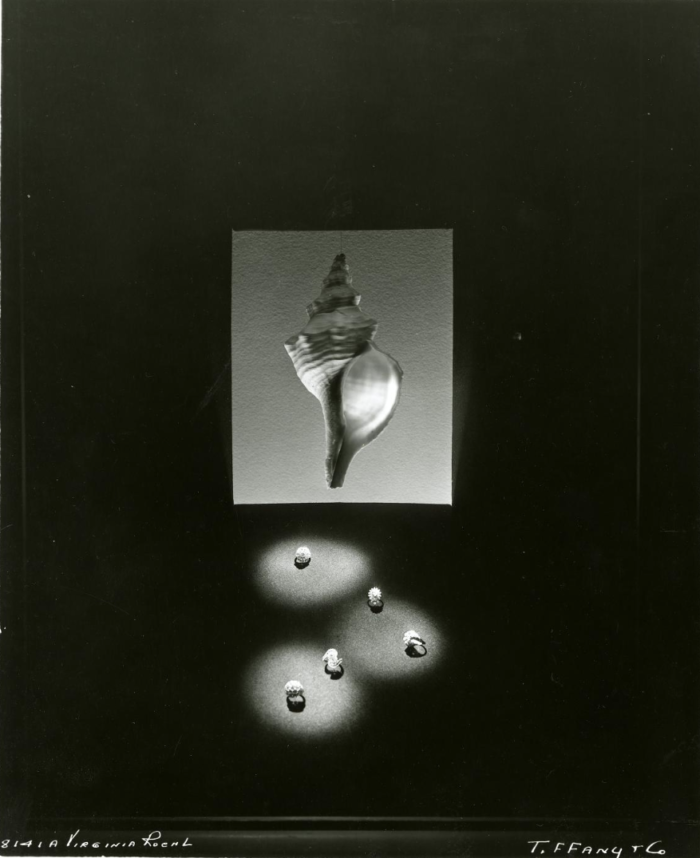
Window Display, January 21, 1960. Photo by Virginia Roehl. Gene Moore, Tiffany & Company Photographs, 1955–1995, Archives Center, National Museum of American History, Smithsonian Institution. AC1280-0000393.
Moore showed how just a few expertly arranged objects could make for a much more compelling and attention-getting visual statement than the packed windows of many of his Fifth Avenue neighbors. It was this contrasting visual impression that made passersby stop in their tracks.
Born in Birmingham, Alabama, in 1910, Moore studied painting at the Chicago Academy of Fine Arts before arriving in New York in 1935. He landed his first display job at I. Miller, where he worked from 1936–38, followed by Bergdorf Goodman in its Delman’s shoe division, and, in 1945, he moved to Bonwit Teller as display director. At Bonwit Teller he collaborated with artists including Andy Warhol, Robert Rauschenberg, and Jasper Johns. Moore joined Tiffany as display director in 1955. His domain was five Fifth Avenue windows, three feet tall, 22 inches deep, each with a width that Moore adjusted to best suit his chosen composition, which often was less than the four feet maximum space available.
When Moore started in 1955, Walter Hoving, chairman of Tiffany’s, gave him free reign to be creative. With some of the most luxurious and beautiful objects that Fifth Avenue had to offer, Moore explained, “I never build anything around merchandise—I make merchandise work for me.”[4] He placed precious jewels in unlikely contexts. A whole series in August of 1956 used a craggily dirt-laden cavern as a backdrop.
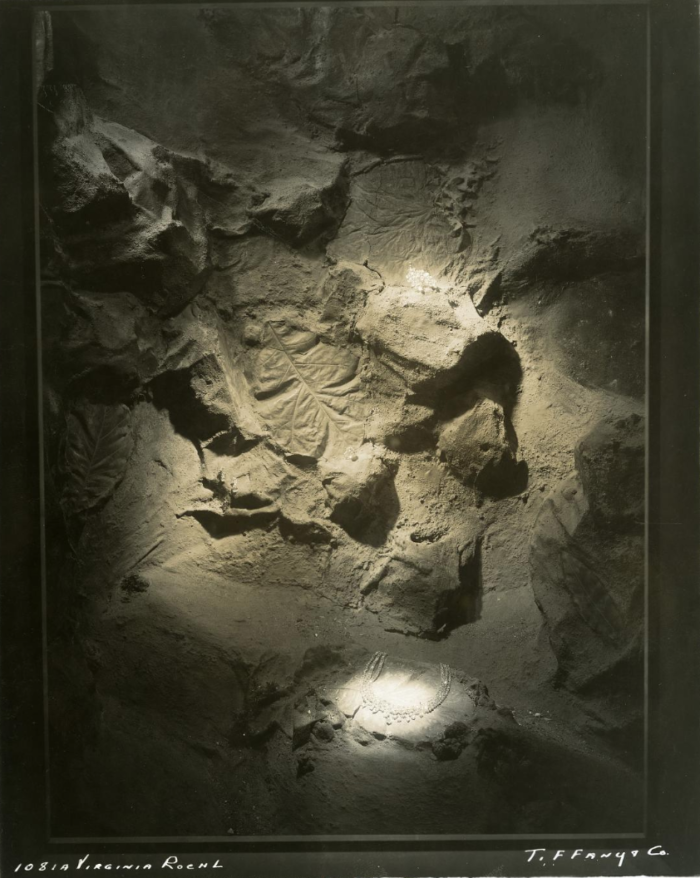
Window Display, August 30th, 1956. Photo by Virginia Roehl. Gene Moore, Tiffany & Company Photographs, 1955–1995, Archives Center, National Museum of American History, Smithsonian Institution. AC1280-0000074.
As if discovering diamonds in the rough, the jewels were spot lit to glow against the rough and natural background. Moore explained that with his window schemes he called attention to the beauty in more than the luxurious Tiffany wares themselves, “I show people things they’ve looked at before but really haven’t seen—like dirt. Dirt can be beautiful.”[5]
Moore used unexpected treatments, such as the use of a backdrop of drab dirt for glamorous jewelry, to guarantee that passersby would stop to examine his windows carefully. Moore identified that there is a difference between looking and seeing. His windows were intellectual and engaged with consumers well beyond the commercial. Moore had a few visual tropes that he used again and again throughout his career: articulated wooden figures, eggs (broken or whole, which he considered to have the most perfect shape), birds, zippers, and keys.
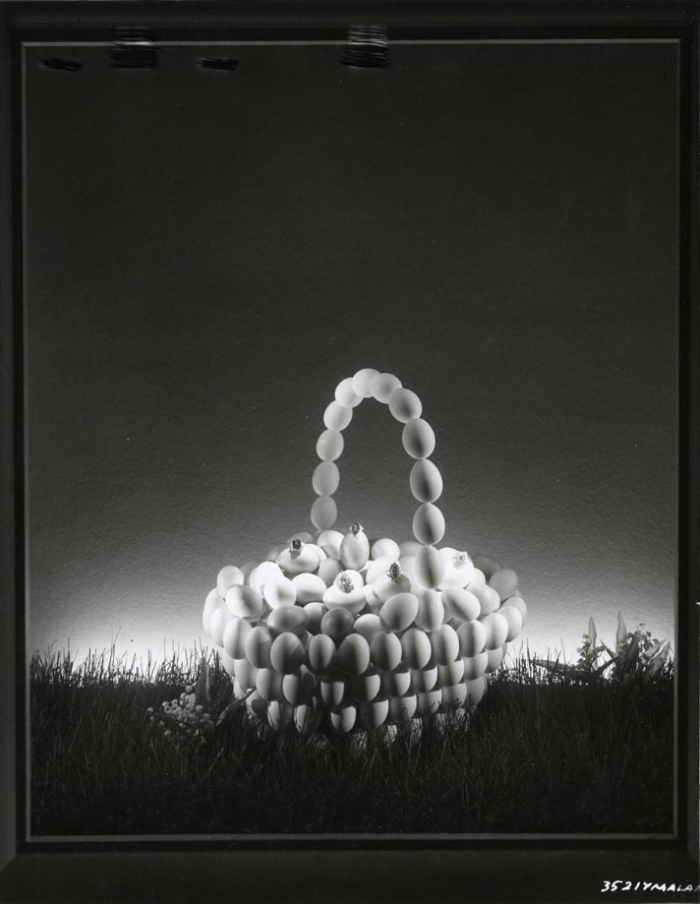
Window Display, April 1, 1965. Photo by Virginia Roehl. Gene Moore, Tiffany & Company Photographs, 1955–1995, Archives Center, National Museum of American History, Smithsonian Institution. AC1280-0000986.
The designs often included visual twists and tricks that demanded careful seeing: broken elements and objects turned backwards or at odd angles that could shock passersby, or jewelry and silver nearly entirely masked by an artistic background that rewarded the public with an element of visual discovery. Moore embraced the beguiling effects of surrealism.
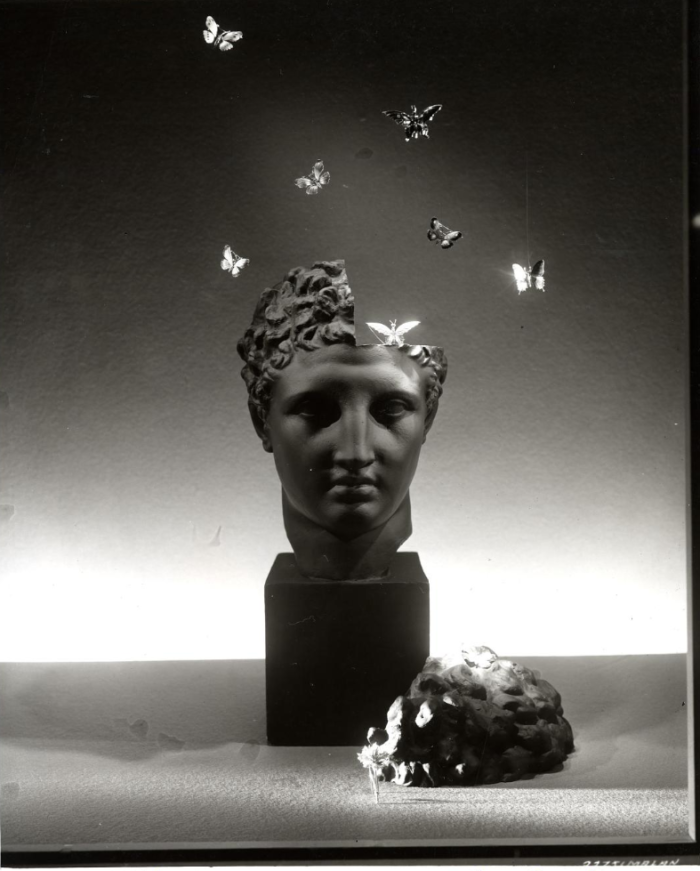
Window Display, November 3, 1960. Gene Moore, Tiffany & Company Photographs, 1955–1995, Archives Center, National Museum of American History, Smithsonian Institution. AC1280-0000475.
He theatrically staged situations that were impossible in reality and sometimes left viewers feeling unsettled with surprising schemes for the storefront of a luxury shop such as Tiffany’s. Moore’s designs often earned their visual impact from the succinctness of the concept conveyed: a necklace in the mouth of a bird or jewelry emanating from a euphonium in the form of musical notes.
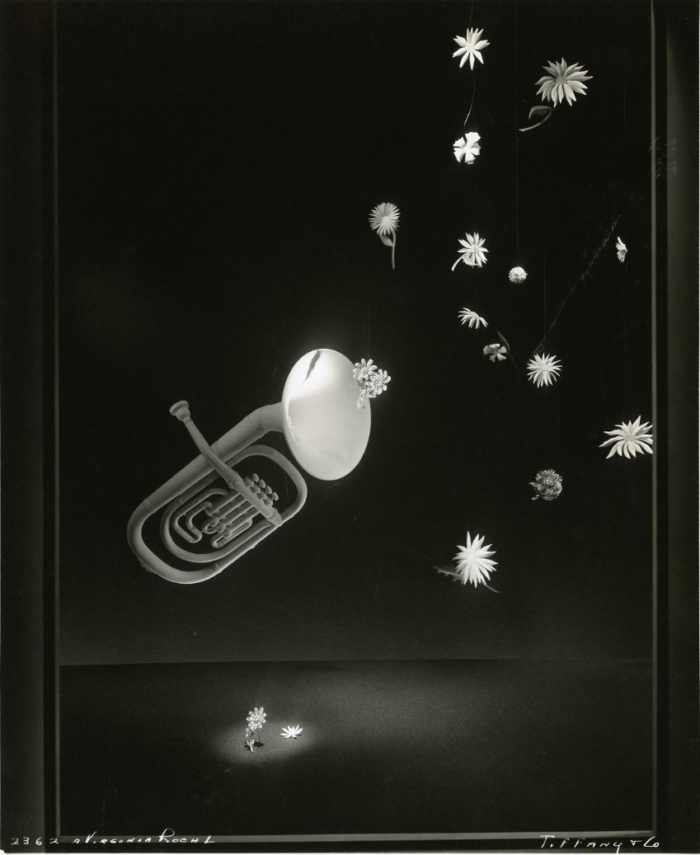
Window Display, April 22, 1957. Photo by Virginia Roehl. Gene Moore, Tiffany & Company Photographs, 1955–1995, Archives Center, National Museum of American History, Smithsonian Institution. AC1280-0000139.
Tom Beebe, Moore’s protégé and chief proponent of the digitization of the archive, reflects on Moore:
It all started with a letter I wrote Gene Moore telling him he is a star; being a southern gentleman, he wrote back, “Thanks Tom—but I am just an old glimmer.” From that moment on, we would meet and talk show windows, inspiration, Magic, shadows, lighting—stopping people in their tracks as they rushed pass our windows. We both believed in Mr. Moore’s mantra: “Everything you are goes into a window—I am my window and my window is me.”
Twenty years ago, I asked Gene to entertain the idea of giving his archive of thirty-nine years of his work to Cooper Hewitt, a museum part of the Smithsonian Institution that recognizes display as design. He agreed, and the board of Cooper Hewitt accepted the seventy-eight albums. I was with Gene the day the collection was being picked up and he was excited that his 4,703 windows [as photographs] were now part of American culture and design history.
Gene Moore is the master window wizard, and his five Fifth Avenue windows were his street gallery museum. His creations became a New York must see destination. Gene has given a rich legacy of window design that included wit, brilliant merchandising savvy, and notoriously unconventional methods for getting people to stop and enjoy his visual merchandising creations.
For me, it has been a rewarding journey to digitize the work these twenty years—1997 ’til 2017—and now Mr. Moore’s archives are just a click away. . . . I am sure Gene is looking down and has peace of mind knowing this work and goal has become a reality. My twenty-year lesson in life has been to pick a great mentor, and he was clever enough to have picked a protégé with perseverance.
The collection Gene Moore, Tiffany & Company Photographs, 1955–1995 was transferred from Cooper Hewitt in 2012 and is now held at the Archives Center, National Museum of American History, Smithsonian Institution. Collection processing and image scanning funded by donors William Rondina and Daniel Gelman.
Notes
[1] “Notion and Novelty Windows,” Merchants Record and Show Window, July 1920, 37.
[2] Émile Zola and Robin Buss, Au Bonheur des Dames (London: Penguin, 2001), 389.
[3] “Fashion: The Modernistic Mannequin,” Vogue, March 1, 1925, 56.
[4] Gene Moore quoted in Joy Wansley, “They’re Just Window Dressing, but Tiffany Sparkles with Gene Moore’s Gems,” People, February 2, 1981.
[5] Ibid.
